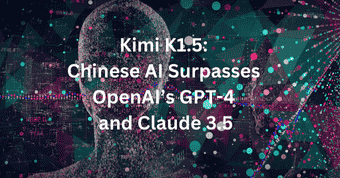After the breakthrough of DeepSeek-R1, another Chinese AI model, Kimi K1.5, has surfaced, pushing the boundaries of artificial intelligence by surpassing OpenAI’s GPT-4 and Claude 3.5 Sonnet on key benchmarks. Developed by Beijing-based startup Moonshot AI, Kimi K1.5 is set to challenge the AI landscape by offering exceptional capabilities that rival the most advanced models globally.
What is Kimi K1.5?
Kimi K1.5 is a multimodal AI system that can comprehend both textual and visual data, including images and videos. Its versatility sets it apart from other models, such as OpenAI’s GPT-4 and Claude 3.5, which are primarily focused on text-based tasks. The Kimi K1.5 model reportedly outperforms these models in various domains, particularly in mathematics, coding, and multimodal input processing, making it a significant leap forward in AI technology.
Moonshot AI, the startup behind Kimi K1.5, has developed this model at a fraction of the cost required to build similar AI systems in the United States. Kimi K1.5 is positioned as the first true competitor to OpenAI’s O1, the flagship AI model known for its problem-solving prowess and ability to handle complex tasks.
Key Features of Kimi K1.5
Kimi K1.5 introduces several innovations, notably in reinforcement learning (RL) and multimodal reasoning. This enables it to process and integrate multiple types of data—text, images, and code—into its problem-solving framework. Unlike conventional AI models that rely on static datasets, Kimi’s learning process is dynamic, driven by exploration and feedback, which enhances its ability to reason and adapt.
Key benchmarks have shown that Kimi outperforms GPT-4 and Claude 3.5 in critical areas. For example, Kimi scored 96.2 on the MATH 500, surpassing GPT-4’s performance. It also scored 77.5 on AIME, a math benchmark, and achieved the 94th percentile on Codeforces, demonstrating its coding abilities. These scores place Kimi ahead of its competitors in both mathematical reasoning and coding problem-solving.
Kimi K1.5’s capabilities extend beyond traditional benchmarks. It is designed to handle long-context tasks, where it can process up to 128k tokens. This feature enables it to manage complex, large-scale data and generate responses based on extensive information. With this, Kimi sets itself apart from other models in terms of efficiency and flexibility.
How Kimi K1.5 Works
Kimi K1.5 utilizes reinforcement learning techniques to improve its decision-making abilities. The RL approach allows the model to “learn” through trial and error, refining its output based on feedback. This differs from the training methods used by many other AI models, which rely more on static data.
One of the standout features of Kimi K1.5 is its Chain of Thought methodology. This approach breaks down complex problems into smaller, more manageable steps, making it easier for the model to reason through solutions. By dissecting problems this way, Kimi is able to arrive at accurate conclusions even in challenging scenarios.
Moreover, Kimi’s capacity to handle long-context tasks—processing up to 128k tokens—gives it a significant advantage in scenarios that require a deep understanding of vast information. Whether it’s analyzing a lengthy document or processing multiple data formats at once, Kimi excels at integrating and responding to large amounts of data effectively.
Multimodal reasoning is another key strength of Kimi. The model’s ability to combine text and visual inputs opens up new possibilities for tasks such as image-text analysis and solving problems that require visual interpretation. This makes Kimi an ideal solution for complex real-world applications where data is not just textual but includes images and videos as well.
The Advantages Over U.S. Models
Kimi K1.5 is not just a step forward in terms of capabilities but also in cost-effectiveness. While U.S.-based models like GPT-4 and Claude often require significant resources for development, Kimi K1.5 has been created at a lower cost, making it more accessible for various applications.
In head-to-head benchmarks, Kimi has outshone GPT-4 and Claude 3.5 by up to 550%, particularly in tasks related to reasoning, problem-solving, and handling multimodal inputs. The model’s efficiency in processing long-context tasks and its advanced capabilities in coding and mathematics give it an edge over its American counterparts, proving that AI innovation is no longer limited to the U.S.
Future Implications for AI
The launch of Kimi K1.5 marks a pivotal moment in the evolution of artificial intelligence. As the first true competitor to OpenAI’s O1, Kimi is setting new standards for what AI can achieve. The model’s ability to handle complex tasks with high efficiency, combined with its multimodal capabilities, positions it as a formidable player in the AI race.
As AI technology continues to evolve, Kimi K1.5’s success may inspire other AI startups to push the envelope further, fostering an environment of innovation and competition. With its impressive benchmarks and breakthrough features, Kimi K1.5 is poised to shape the future of AI, challenging existing paradigms and opening up new possibilities for both commercial and research applications.







